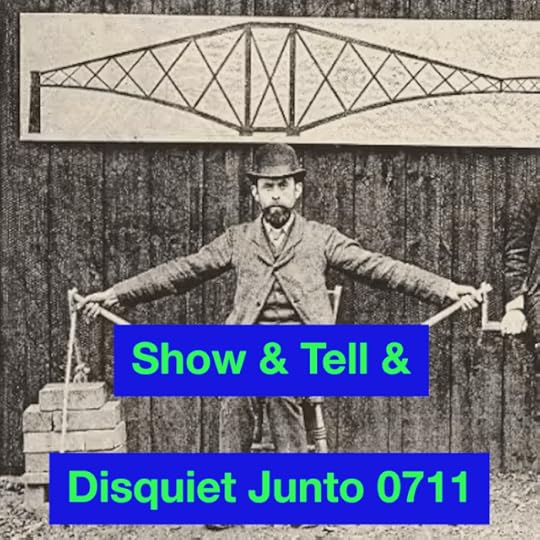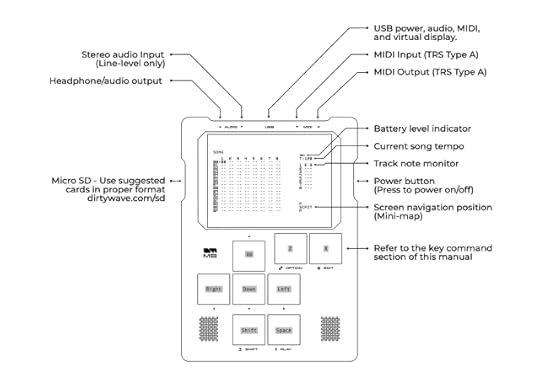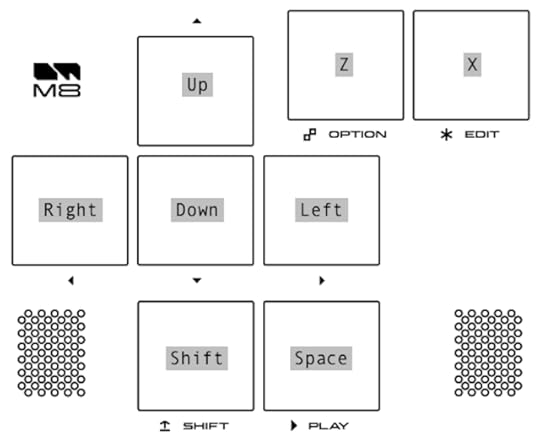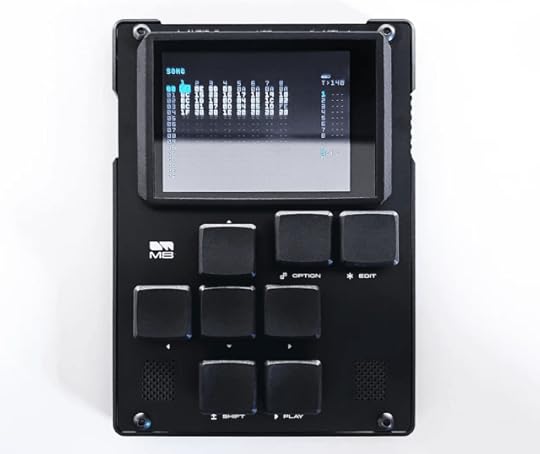Marc Weidenbaum's Blog, page 10
August 20, 2025
Faux Richter

Definitely enjoying getting back into photography. Current mode: faux Gerhard Richter.
August 19, 2025
Geo-Curious
I went for a walk at the end of the day, down to the Bay at China Beach, here in San Francisco, and I encountered two microphone installations toward the end of the road. There’s a lot of construction going on, both domestic and municipal, and these boxes appear to be either seismic or noise monitoring setups. Maybe both. The company employed to do the monitoring is Integrated Geotechnical Solutions, Inc. (more at igs-inc.com). I stood at both sites, contemplating aloud what they might be, fully aware I was doing so with microphones in plain sight, but also wondering if the mics were even concerned with signals audible to human ears. One of the boxes employs solar power. The power source of the other was unclear. I have a tiny little noise monitor, called the AudioMoth, and these seem to be sort of like large, industrial versions of that. I hope to learn more.


August 17, 2025
Two Views of Fuji
When you spend the week looking into cameras by watching YouTube videos, you frequently come across moments such as these:


August 16, 2025
Scratch Pad: Quiet, Architecture, Comics
At the end of each week, I usually collate a lightly edited collection of recent comments I’ve made on social media, which I think of as my public scratch pad. I find knowing I’ll revisit my posts to be a positive and mellowing influence on my social media activity. I mostly hang out on Mastodon (at post.lurk.org/@disquiet), and I’m also trying out a few others. And I generally take weekends off social media.
▰ If you really want your neighborhood to feel quiet, have it host three-day music festivals two weekends in a row. The Monday after is eerily still.
▰ It’s funny the library is all “be quiet” ’cause this rattly old book cart a librarian is pushing across the floor is loud as heck
▰ They say that writing about music is like dancing about architecture — but what does that mean for architraves?
▰ Trying a new format on Instagram. I’m generally not into sharing without adding some sort of context, even a grace note, so this treatment may wither on the vine, or evolve. We’ll see.

▰ Me watching TV before bed: Hey, I’m halfway through the second episode of Alien: Earth and maybe this isn’t good to watch before bed. Hey, there’s a new Tyler, the Creator video, “Sugar on My Tongue,” so I’ll watch that. Hey, what’s up with that knife? …
▰ Annoying: accounts that list all their photo gear.
Also annoying: accounts that list none of their photo gear, so I have to email them to ask.
▰ I’ve spent much of my adult life trying to remember it’s Harriet Walter not Harriet Walker, and then she plays a character named Walker on Silo, and I’m trying to sort out if this will aid or hurt my attempts to keep it straight.
▰ Books read this week: I finished the four most recent (that is, in English translation) volumes of Masakazu Ishiguro’s Heavenly Delusion (through v7), and I’m pretty hooked. The 8th should be out by the end of the year. ▰ I finished volumes 2 through 4 of Kazuo Umezz’s My Name Is Shingo, with one more to go … before I have to wait until the 6th/final volume comes out. ▰ I read Will McPhail’s In. (yes, there’s a period in the title), about a young urban professional suffering from anhedonia, in one sitting. I especially appreciated how different pages used not just the structure of the panels but the overall amount and shape of the white margins differently. ▰ I read Erik Svetoft’ Spa, about the dark — in a supernatural sense — goings-on at the titular location. ▰ I’ve been looking forward to DC’s Absolute series coming out as collected volumes. I read the first two, Absolute Batman (from writer Scott Snyder and illustrator Nick Dragotta) and Absolute Wonder Woman (from writer Kelly Thompson and illustrator Hayden Sherman). I’m not sure I entirely get the point of the Absolute books. They’re reboots of famous characters, so sort of like the classic Elseworlds titles, but somehow distinct from that line (aside from being ongoing, how exactly is unclear). The “Absolute” Batman, for example, isn’t rich, but since O.G. Bruce Wayne’s playboy persona was a cover, the difference from an ethical perspective isn’t as stark as it might seem — at least not so far. Now, the Wonder Woman volume, on the other hand, was really something. I’ve never, in the past, been very interested in the character, and her story here seems much richer than the isolationist myth of the classic version. In contrast, Absolute Wonder Woman was sent, as a child, to the underworld, where she was raised by Circe. I’ll say this: Sherman has immediately become one of my favorite comics illustrators. I’ll be digging into his back catalog immediately. The guy puts in the work. Every page, every frame, is rich with detail, and every line with texture. (There’s also a side story illustrated by Mattia de Iulis, and some chibi strips drawn by Dustin Nguyen.)
August 15, 2025
Tome Raider

File under “not clear on the concept.” The “organize yourself” title is icing on the communal cake.
August 14, 2025
Disquiet Junto Project 0711: Show & Tell &

Each Thursday in the Disquiet Junto music community, a new compositional challenge is set before the group’s members, who then have five days to record and upload a track in response to the project instructions.
Membership in the Junto is open: just join and participate. (A SoundCloud account is helpful but not required.) There’s no pressure to do every project. The Junto is weekly so that you know it’s there, every Thursday through Monday, when your time and interest align.
Tracks are added to the SoundCloud playlist for the duration of the project. Additional (non-SoundCloud) tracks also generally appear in the lllllll.co discussion thread.
Disquiet Junto Project 0711: Show & Tell &
The Assignment: Share some recent music; get and give feedback
Step 1: Choose a track/composition you’re working on. Share the recording on the Lines forum on the llllllll.co discussion thread at:
https://llllllll.co/t/disquiet-junto-project-0711-show-tell
Step 2: When posting the track, mention that you’re looking for feedback, describe what you’ve been up to on the track, and if applicable specify some aspects of the recording you might want input on.
Tasks Upon Completion:
Label: Include “disquiet0711” (no spaces/quotes) in the name of your track.
Upload: Post your track to a public account (SoundCloud preferred but by no means required). It’s best to focus on one track, but if you post more than one, clarify which is the “main” rendition.
Share: Post your track and a description/explanation at https://llllllll.co/t/disquiet-junto-project-0711-show-tell/
Discuss: Listen to and comment on the other tracks.
Additional Details:
Length: The length is up to you.
Deadline: Monday, August 18, 2025, 11:59pm (that is: just before midnight) wherever you are.
About: https://disquiet.com/junto/
Newsletter: https://juntoletter.disquiet.com/
License: It’s preferred (but not required) to set your track as downloadable and allowing for attributed remixing (i.e., an attribution Creative Commons license).
Please Include When Posting Your Track:
More on the 711th weekly Disquiet Junto project, Show & Tell & — The Assignment: Share some recent music; get and give feedback — at https://disquiet.com/0711/.
August 13, 2025
Manga Tape Deck

I’ve been on something of a manga bender lately, and so I share this one panel from Masakazu Ishiguro’s very enjoyable series Heavenly Delusion. There a light echo of Akira Toriyama’s work in Ishiguro’s, a gentle roundness to some of the technology, as in this depiction of a portable tape recorder.
August 12, 2025
M8 Headless Cheat Sheet

The above image is borrowed from the manual for the M8 Operation Manual. This shows the layout for the physical M8 Tracker device. The text in gray on the eight buttons on the bottom half of the device is what I’ve added to the provided image. Here is a more useful detail:

Those eight keys are, I believe, the default settings for using a computer keyboard as replacements for the physical buttons on the official M8 Tracker. From my experience with the M8 Tracker, you cradle it with both hands and control the buttons with your thumbs, though I imagine some people may rest the device on a table, or lap, and employ additional fingers.
This is a picture of the first version of the M8, which is the one I have. There’s a more recent version, but the buttons are in the same place.

I’m trying to port some of my experience with the official device to running the software on a Teensy 4.1, connected to my laptop with a USB cable, as I’ve mentioned here recently. The transposition gets a little confusing, in part because I’m inclined to use more than just my thumbs on my laptop, and also because the arrow keys are on the lower right side of my laptop keyboard but on the upper left side of the M8 Tracker. Much M8 use is muscle memory.
I’ll continue to track, so to speak, as I explore the M8 Tracker further.
August 11, 2025
Kronos in the Red (Hot)
Kronos Quartet has released an EP to coincide with the 80th anniversary of the Trinity Test, the first nuclear detonation, back in July 1945. The EP, available on Bandcamp, has three tracks. The first is an extended version of Bob Dylan’s “A Hard Rain’s a-Gonna Fall,” its vocal a composite of sections sung by numerous musicians, including Allison Russell, Iggy Pop, Stephin Merritt, Gustavo Santaolalla, Laurie Anderson, and Willie Nelson. There’s also an expanded ensemble, including Santaolalla on ronroco and Chris Geddes on Hammond organ, plus many other players, and a sizable chorus.
The second and third track take the concept further, and further still. A “drone” version eschews familiar instrumentation in favor of an extended sonic bed, above which spoken lyrics are more layered (even cut-up) than in the first take, spoken by Ocean Vuong, Charlotte Gainsbourg, Ringo Star, and many others. (I’d love if Kronos also put out the isolated instrumental of this one.)
Finally, there’s a spirited raga inspired by Kronos’ efforts, performed by Terry Riley with Sara Miyamoto, who teamed with Kronos previously on a re-imagining of Sun Ra’s music. The Riley/Miyamoto piece, “Komal Reshab Asavari,” came out the month prior to coincide with Riley’s 90th birthday, and then was included in this release.
All these were collaborations with Red Hot Org. Kronos now has just one of its founding members, violinist David Harrington, plus cellist Paul Wiancko, who joined two years ago, and violinist Gabriela Díaz and violist Ayane Kosaza, who joined last year.
August 10, 2025
M8 Headless Experiment

This was a satisfying series of initial steps. I have an M8 Tracker, which is a music-making device that combines a sequencer (hence the name “tracker”), a synthesizer, and a sampler, all in the palm of your hand. The M8 exists in part because of the creative opportunities afforded by the Teensy (specifically the 4.1), an inexpensive (roughly $35US) circuit board for product development.
Since the M8 runs on this common tool, and because Dirtywave, the manufacturer of the M8, makes its software available for download, you can make your own M8 equivalent pretty easily. Doing so is usually accomplished by hooking a Teensy to a game system or a laptop. I decided to try the latter, using a MacBook Pro, to begin with. This process is called a “headless” approach, though it’s not quite headless, because you’re using the game system or laptop as the screen.

The instructions, as laid out on Dirtywave’s GitHub documentation, were fairly easy to follow. I only encountered two sources of confusion:
First: Under Step 3 (“Install a M8 Display Client and Run M8 Headless”) of the headless process, there are three primary options for the Teensy to feed visuals through the laptop. However, the way it’s written out, it looked to me like the first two options had one step, whereas the third option had multiple steps. I didn’t initially understand those subsequent steps applied the first and second options, as well.
Second: I was confused that when the Teensy connected to my laptop via a USB cable, I didn’t see the SD card mounted via the MacBook’s file system. The SD card not appearing in the Finder meant I couldn’t transfer audio files, like beats and field recordings. I eventually sorted out that I needed to remove the SD card, and put it separately into the laptop in order to transfer files. Not a big deal, but this wasn’t self-evident to me. I interpreted this as a problem to be solved, not a norm I had to work around.
And that about covers it. The M8 Tracker is now running headless on my laptop, as shown up above. I ordered a little $10 plastic case to (somewhat) protect the Teensy 4.1, which is just a raw circuit board. And I’ll be experimenting some more.
The primary reason I did all this was because I’ve been looking into alternate firmware, and while to my knowledge there is no fork of the M8 software, this project was useful to give me some experience with flashing software to the Teensy. Also, I really enjoy my M8 Tracker, and using the headless Teensy version means I’ll have more ways to play around with the system.



